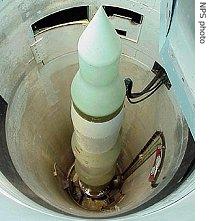2007年VOA标准英语-Former US Nuclear Missile Site Open to Public
搜索关注在线英语听力室公众号:tingroom,领取免费英语资料大礼包。
(单词翻译)
By Greg FlakusCactus1 Flat, South Dakota
21 June 2007
During the Cold War, the United States and the Soviet2 Union targeted each other with thousands of missiles armed with nuclear warheads. Both countries took measures to prevent human or mechanical errors that could have led to a disastrous3 conflict in which the world as we know it likely would have ended. There are still nuclear missiles in place, but relations between the United States and what is now Russia are much improved. Today, visitors to a remote area of South Dakota can see firsthand a missile silo and launching station that are no longer in use and experience what it must have been like for the military men and women who held the fate of the world in their hands. VOA's Greg Flakus has the story from Cactus Flat, South Dakota.
 |
| Minuteman missile |
"If you look on the left side of the missile, you see an umbilical cord attached to it," Wilkinson said. "That is where the underground communications cables which connect with the launch control center bring a positive launch command into the missile's computer."
This missile no longer has a nuclear warhead and is no longer capable of flight. It is here only as a display for visitors to what is now called the Minuteman Missile National Historic Site. It was authorized5 by Congress in 1999 and has been operated by the National Park Service since 2004.
This is the only site in the national park system devoted6 to the Cold War. It came into existence under a provision of the 1991 START treaty between the United States and the Soviet Union. Under the treaty, all Minuteman II missiles were deactivated7 and the sites destroyed, with the exception of one site that could be used for educational purposes. This site near the South Dakota Badlands, a scenic8 landscape of eroded9 hills, was chosen for development of the park.
| Delta 1 launch facility |
"America's military policy during the Cold war as far as nuclear weapons go was one of deterrence11," Wilkinson said. "Thus, we had them out there, right in the open, where even Soviet satellites could see them, so, hopefully, they would not attack us. One of the main ideas behind deterrence is that your enemy knows you have a credible12 system that works."
Wilkinson says two-person teams came into the launch center every day to work day-long shifts in an underground bunker, using top secret codes to gain access.
"Once they had deemed those codes authentic13, this door, which was always kept closed and secured, would be buzzed open by the on duty crew down below," Wilkinson said. "Then a new missile crew could open this door on up. They would step into this elevator and head down for a 24-hour shift."
At the bottom of the elevator shaft14 there is a short walkway to a massive, eight-ton door that would close the launch team into a small room filled with control panels and technical equipment. Each team consisted of a commander and a deputy commander, neither of whom could carry out a launch without the other. If a launch order had ever come, each man had exact duties.
"The commander would meet the deputy at this red locked safe box," Chris Wilkinson explains. "They each have their own separate locks on it," Wilkinson said. "They take those off as fast as they can. They open that box up. Inside of it, they find a set of keys."
Both keys and both people were needed to initiate15 launch.
"The deputy would insert their key right here, the commander does the same and inserts their key right here," Wilkinson said. "They are 12 feet apart and they must be turned simultaneously16. So if somebody goes bonkers in the middle of the night and shoots their partner, it is going to be impossible for one person to turn both keys at the same time."
On the other side of the world, the Soviets17 had a similar system, but in September 1983, according to documents that became available after the collapse18 of the Soviet Union, the unthinkable almost happened.
Lieutenant19 Colonel Stanislav Petrov received information indicating the United States had fired missiles that were on their way over the North Pole. He doubted the information and held off sending it to higher authorities who might have ordered a counterattack. It turned out to be a computer error.
Petrov, now retired20, came to visit the South Dakota missile site in May, and Chris Wilkinson had a chance to meet the man who many believe saved the world.
"It really brought home to me how, even though we live in this world of technology and all, it all comes down to human decision making and it is just ordinary people like myself or like Petrov or like yourself who make decisions every day that really decide the fate of the world," Wilkinson said.
There were once 150 Minuteman II missiles in South Dakota and over a thousand scattered21 around other parts of the northern plains. There are no more active missile sites in South Dakota now, but there are still other types of nuclear missiles in nearby states.
The Minuteman Missile National Historic Site serves to remind visitors of the frightful22 technology available to humans and the need to be ever vigilant23 and careful so that it is never used.
 收听单词发音
收听单词发音 




